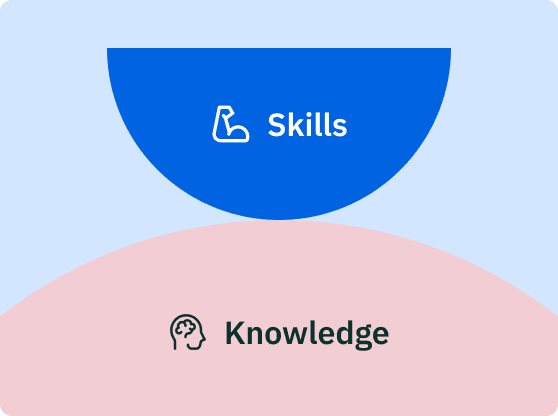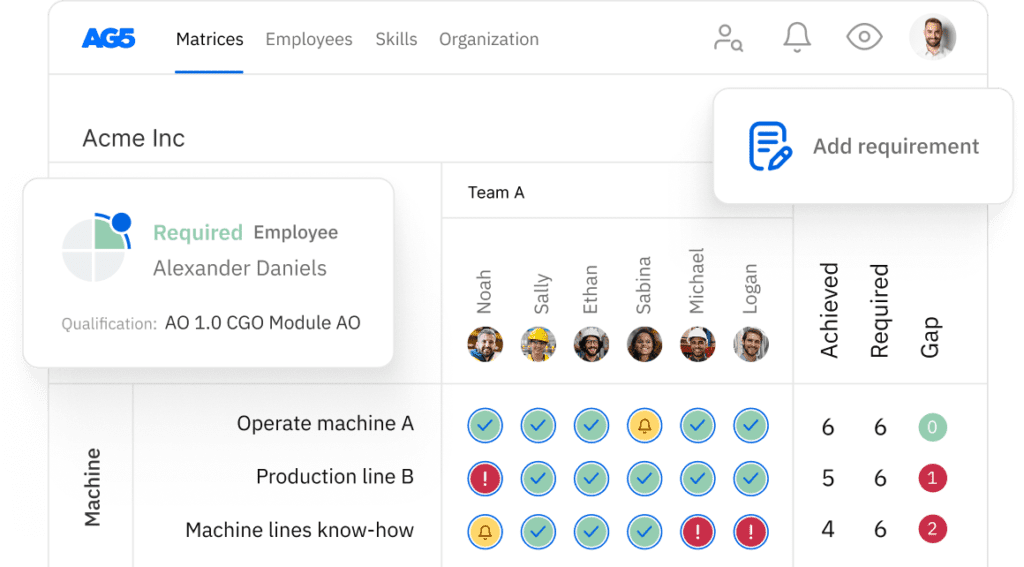Everything you need to know about employee skills assessment
In this article, we cover all aspects of employee skills assessment, including methods and benefits for organizational development and success.

A skills assessment determines the skills your employees have, individuals or as an organization as a whole. In this article, we’ll take a look at everything you need to know about employee skills assessments, including their benefits, types, and tips for conducing them in your organization. Additionally, we’ll show how AG5 can help you develop and implement employee skills assessments that are as effective and comprehensive as possible.
What is an employee skills assessment?Copied
An employee skills assessment is a thorough evaluation of an individual employee’s proficiency in various knowledge, skills, and competencies. The aim is to accurately determine whether a person can effectively perform – or is effectively performing – a specific task or role. [1]
The benefits of employee skills assessmentsCopied
By conducting employee skills assessments, you can develop deeper insight into the skills present in your organization – as well as those it needs.
This makes it possible to:
- Identify and close skills gaps
- Build and organize holistic teams and departments
- Develop recruitment, upskilling, and reskilling initiatives based on the skills your organization needs
- Find replacements for employees off sick or who have left the company
- Identify high-performing employees, with specialized or extensive skill sets
How to conduct a employee skills assessmentCopied
Conducting an employee skills assessment can be boiled down to a simple, four-step process. Let’s take a look.
1. Determine which skills you’re going to assess
Determine the skills you want to map and monitor. You can use your organization’s job descriptions for this purpose. Select the most important roles first, then work your way down the list. Skills assessments aren’t a race to the finish, instead requiring a comprehensive approach that is better taken methodically.
2. Communicate your intentions
Clearly communicate to your teams and employees that skills assessments are not designed to find the weakest link, but to identify and close skills gaps within the organization. Effective employee skills assessments hinge on buy-in and cooperation at all levels of the organization, so be sure that you leave time and space for employees to provide you with feedback, questions, or other concerns.
3. Collect your skills-related data
To collect data for your skills assessments, consider using one-on-one conversations, surveys, observations, tests or other on-the-job evaluations – all of which can help you determine where there might be skills gaps within your organization. [2] There’s no right way to gather the data you’ll need, so use every resource you can, both formal and informal.
4. Analyze your data
Next, you’ll need to analyze the data you’ve gathered. Are there any discernible trends? Can you deduce anything about your recruitment strategies or training programs? Thorough analysis allows you to make data-driven decisions.
Types of employee skills assessmentsCopied
You can tweak your approach to employee skills assessments to target specific areas or categories of skills. Here, we’ll explore a few of the most common types of employee skill assessments.
Hard and soft skills assessments
Hard skill assessments measure employees’ proficiency in specific, teachable abilities, such as or machine operation. They help you determine if your employees have the technical expertise required for their roles.
Soft skills assessments [3] evaluate interpersonal and intrapersonal abilities like communication, teamwork, and adaptability. They are extremely important for roles that require effective collaboration and leadership.
Behavioral and personality assessments
Behavioral assessments evaluate how employees behave in various situations, and often take the form of behavioral interviews, situational judgment tests, and simulations. They help predict future job performance and cultural fit by assessing past behaviors and responses to hypothetical scenarios.
Personality assessments, on the other hand, measure individual personality traits and psychological attributes. Popular assessments include the Myers-Briggs Type Indicator (MBTI) [4] and the Big Five personality traits [5], which help organizations understand an employee’s typical behaviors, motivations, and compatibility within teams and the organization as a whole.
Cognitive and aptitude tests
Cognitive and aptitude tests measure general mental abilities such as reasoning, memory, problem-solving, and comprehension. You can use them to job performance by evaluating an individual’s potential to learn and adapt to new situations. Additionally, aptitude tests can be a great way of determining if an employee is a good candidate to be reskilled or upskilled.
Tools for employee skills assessmentsCopied
Not only will the right tools make conducting employee skills assessment much easier, they’ll also ensure that they are as effective as possible.
Management platforms
Online management platforms like learning management systems (LMS) and talent management systems (TMS) often provide tools for mapping and tracking employees’ skills. A big plus here is that many organizations are already using some form of management system in their day-to-day operations, meaning the infrastructure already exists and setup is less resource intensive.
Skills matrices
A skills matrix is perhaps the most useful of the tools you can use to develop and conduct employee skills assessments, as they help you map your employees’ skills and competencies clearly and concisely.
With a skills matrix, you can also enter and track individual proficiency levels for each employee and skill listed. This allows you to make use of an at-a-glance overview of the skills your employees have and need, as well as the employees whom are most versatile and flexible. Spreadsheet-based skills matrices are typically how organizations start when conducting employee skills assessments.
Skills management software
As their skills management strategies become more complex and comprehensive, many organizations find that spreadsheets are too complicated to maintain. That’s when we see many organizations move on to skills management software like AG5, which provide a platform that allows you to track and manage employee skills across the entire organization – even across multiple sites.
Conduct employee skills assessments with AG5Copied
AG5’s skills management software replaces spreadsheets and stores all skills-related information on a centralized hub in the cloud. Authorized individuals, teams, or departments can then access and update this information to ensure that you can conduct employee skills assessments more easily and effectively than ever.
With AG5, you can:
- Enter updates and training results from the shop floor in real time
- Assign staff to projects based on current skills, expertise, proficiency level, experience, and more
- Set notifications for individuals, groups, or qualifications
- Find qualified replacements quickly and easily to retool production lines
- Quickly find the best replacements for employees off sick or on vacation
- Map the skills and expertise available at other sites
- Replicate organizational structures and link employees to skills and qualifications with easy-to-use, drag-and-drop functionality
Want to see how this would work in your organization? Schedule a free, live, 15-minute demo for a customized look at AG5 in action.
Sources Copied
- Change view: Table
-
APA
| # | Source title | Description | Publication | Retrieved | Source URL |
|---|---|---|---|---|---|
| 1 | Robust skill sets demand holistic assessments | Deloitte | - | July 4, 2024 | https://action.deloitte.com/in.. |
| 2 | Using skill gap assessments to help future-proof your organization | McKinsey & Company | - | July 4, 2024 | https://www.mckinsey.com/capab.. |
| 3 | Soft skills, strong impacts | McKinsey & Company | - | July 4, 2024 | https://www.mckinsey.com/featu.. |
| 4 | Myers & Briggs Foundation | Myers-Briggs® Overview | - | July 4, 2024 | https://www.myersbriggs.org/my.. |
| 5 | Big 5 Personality Traits | Psychology Today | - | July 5, 2024 | https://www.psychologytoday.co.. |

